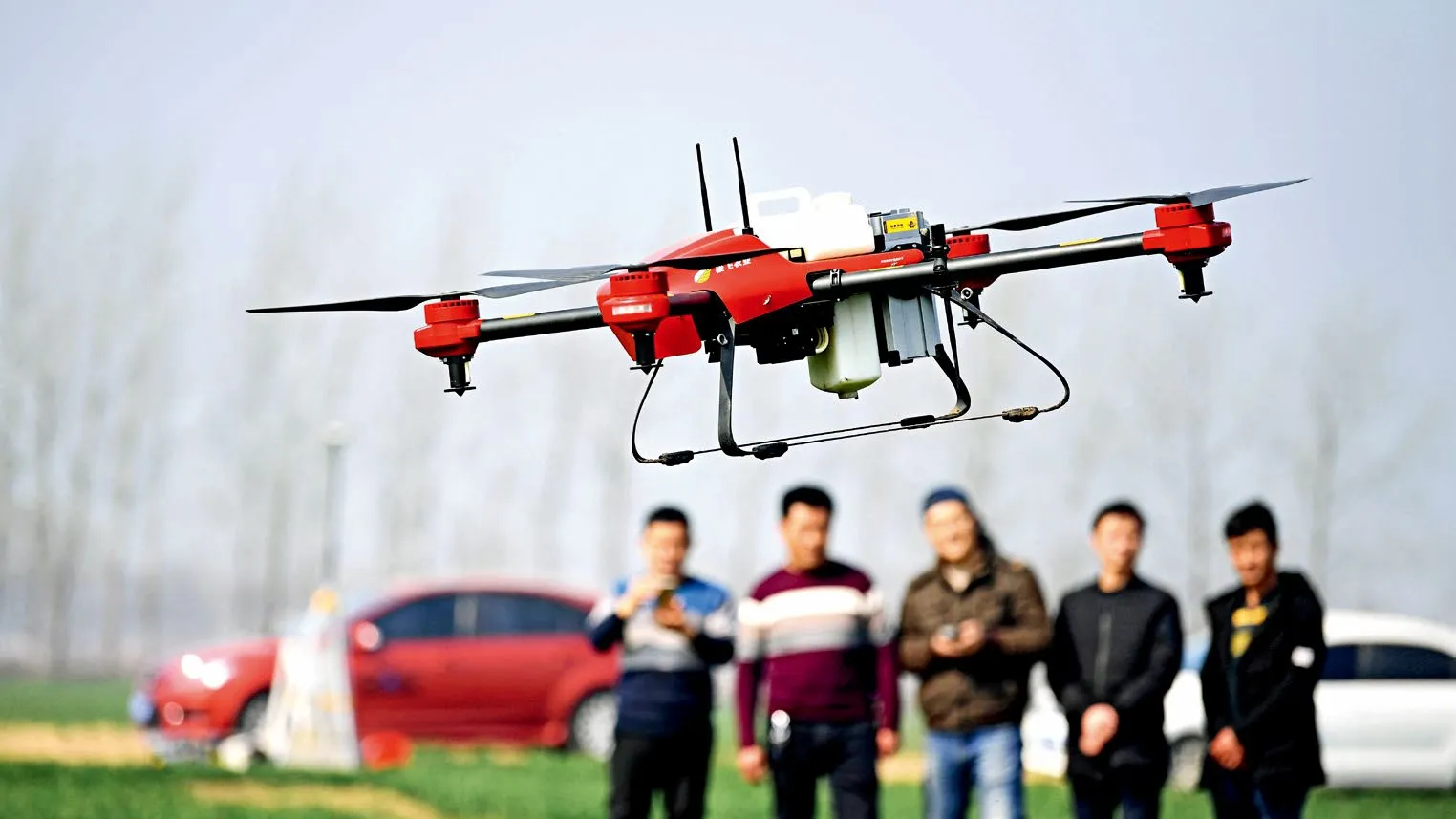Smart Farming Flies High
By Shen Juan
Smart Farming Flies High
By Shen Juan
Agricultural drones simplify the process of protecting and fertilizing crops

Technicians examining an agricultural drone.
China is a large agricultural country, with 120 million hectares of farmland. Each year, enormous resources are invested in the protection of crops. Improving the efficiency and safety of pesticide spraying operations has long been a concern for farmers and relevant governmental departments.
With the advancement of unmanned aerial vehicle (UAV) technology, plant protection drones have gradually become important intelligent agricultural equipment. The utilization of such equipment has not only enhanced the efficiency and safety of agricultural operations, but also pushed China closer to an era of smart farming.
Maturing Technology
In May 2016, China’s Ministry of Agriculture (MOA) published a document titled Notice of the MOA General Office on Carrying Out Statistical Surveys Concerning UAVs for Agricultural Plant Protection. The MOA carried out surveys of agricultural UAVs for the purpose of fully grasping the situation of the development of agricultural plant protection drones. To this end, agricultural machinery and farming authorities at various levels were required to report information including numbers of agricultural drones and their operation areas.
Beijing TT Aviation Technology Company founder Yang Yi told Yuchen360.com, a UAV e-commerce platform, that China’s plant protection drone market has taken shape thanks to joint ef f orts by the government and UAV manufacturers in recent years. Furthermore, policies of providing subsidies for the development of agricultural UAVs implemented by the MOA and agricultural authorities of Henan, Fujian, Jiangxi and other provinces have injected vitality into the market.
Li Xiangyu, a marketing supervisor with the Wuxi Hanhe Aviation Technology Company, pointed out that preferential policies aimed at the popularization of smart farming and smart agriculturalequipment are a huge driving force for plant protection drones. Smart equipment has been widely used in the planting, seeding and harvesting of crops in the majority of China’s rural areas. New policies are just now beginning to impact weeding and pesticide spraying as UAVs take on a greater role in such tasks.
“We must realize that just adding a spraying system to UAVs cannot enable them to become plant protection drones conducive to agricultural innovation,” Li added. A qualif i ed plant protection drone should not only meet certain requirements in terms of pesticide loading capacity and fl ight duration, but also be able to take of f and land in complex environments of croplands and perform precision spraying efficiently.
Along with technological upgrades and progress, a number of plant protection drones hit the market in 2016. For instance, the P20 V2 Agricultural UAV System, released by XAircraft in October 2016, is equipped with an RTK positioning system, which enables it to achieve centimeterlevel precision autonomous fl ight. The Mercury-1 ducted fan helicopter, a third-generation plant protection drone unveiled by the Wuxi Hanhe Aviation Technology Company in November 2016, made new breakthroughs in terms of pesticide loading capacity and smart programing.
Use in Various Aspects of Agriculture
China’s plant protection drone market has great potential. Statistics show that Japan has more than 3,000 registered agricultural UAVs and some 14,000 operators, ranking it fi rst in terms of spraying drones around the world. China has 28 times more paddy fi elds than Japan. Industry experts estimate that China will need 100,000 plant protection drones and 400,000 UAV operators by 2020.

An agricultural drone fl ies over farmland.
According to Li Xiangyu, China’s agricultural UAV market is still in its preliminary stages, but has already seen rapid development. So far, only 2 percent of the country’s farmland utilizes spraying drones. The market size will quintuple if the proportion reaches 10 percent, and increase tenfold if China reaches the same level as global averages.
Along with the adjustment of China’s agricultural structure, farmers’ demand for agricultural machines, technology and other supplementary tools has become increasingly urgent. Plant protection drones have drawn wide attention for their advantages in pesticide spraying, wind pollination and remote cropland sensing.
Yi Yulin, head of an agricultural technology company based in Zhijiang, Hubei Province, runs a plant protection UAV team. He pointed out that China has a huge market for plant protection drones.
“Almost every farmer acknowledges the advantageous role of UAVs once he or she uses such equipment to spray pesticides,” Yi said. “Nowadays, farmers in Hubei Province prefer fully-automatic spraying drones because they worry that manually-operated spraying UAVs may not cover all the cropland required.”
According to Yi, his team’s clients are mostly large plantations and orchards because large-scale operations may cut costs. He also stressed that time is needed to raise awareness of plant protection drones among rural communities.
“Last year the market gradually began to take shape, as agricultural UAV technology matured and was accepted by increasing numbers of farmers,”Yi added. “When working in a client’s fi eld last year, some nearby farmers took interest, asking us to use drones to spray their fi elds. If we continue growing our market this year, spraying drones should become widely popular by 2018, just like tractors and reaping machines.”
China’s fast growing agricultural UAV market has caught the attention of a number of foreign companies. Yang Yi said that some UAV fi rms in ASEAN countries have made preliminary contact with his company, and that China is willing to share its experience in this area with ASEAN countries and help them elevate their levels of agricultural mechanization.
- China Report Asean的其它文章
- FREIGHT TRAIN ROUTE LINKS VIETNAM, SOUTHWEST CHINA
- The CPC Grows Together with the Chinese People
- South and Southeast Asia Commodity Expo and Investment Fair Held
- COOPERATION WITH SINGAPORE GROWS
- Xi's Kazakhstan Trip Cements Broader Cooperation
- THAI PM SET TO SPEED UP THAILAND-CHINA RAILWAY PROJECT

